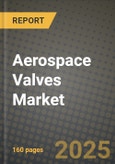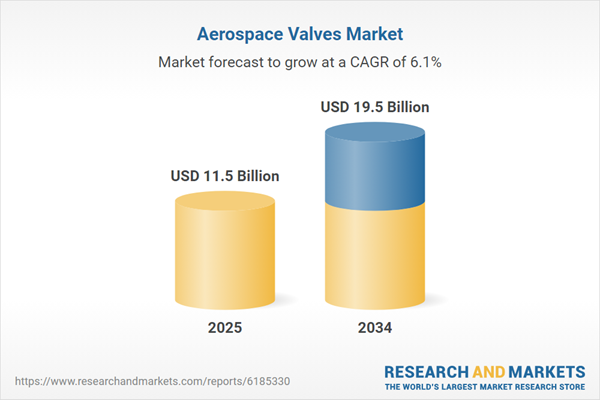The aerospace valves market is growing steadily due to the increasing demand for efficient fluid and pressure control systems in modern aircraft. Aerospace valves play a crucial role in hydraulic, fuel, pneumatic, and environmental control systems, ensuring optimal aircraft performance and safety. With the rise in aircraft production and fleet modernization initiatives, manufacturers are focusing on developing high-performance, lightweight, and durable valve solutions. Advanced materials such as titanium and composites are being integrated into aerospace valves to enhance efficiency and reduce weight. Additionally, the growing trend toward electrification in aviation is driving innovations in smart and electronically controlled valve systems.
The aerospace valves market is witnessing significant technological advancements, with increased adoption of AI-driven predictive maintenance and smart valve monitoring systems. The shift toward fuel-efficient aircraft is leading to the development of high-precision fuel control valves that optimize combustion and reduce emissions. The growing use of additive manufacturing is also transforming aerospace valve production, enabling more complex and lightweight designs. Meanwhile, the increasing deployment of unmanned aerial vehicles (UAVs) and electric propulsion systems is driving demand for specialized valve solutions tailored for these emerging aircraft platforms. With the aviation industry focused on operational efficiency and sustainability, the market for advanced aerospace valves is expanding rapidly.
The aerospace valves market is expected to benefit from advancements in digital twin technology, enabling real-time monitoring and predictive diagnostics for enhanced system reliability. The development of high-temperature-resistant valves for hypersonic and space applications will further expand market opportunities. The rise of hydrogen-powered aircraft will create new demand for cryogenic valve solutions capable of handling extreme conditions. Additionally, improvements in lightweight composite materials will enable the production of even more durable and corrosion-resistant aerospace valves. As aviation moves toward autonomous and AI-driven operations, the need for intelligent, self-regulating valve systems will continue to grow.
Key Insights: Aerospace Valves Market
- Integration of AI and IoT in Aerospace Valves: Smart aerospace valves with real-time monitoring and predictive maintenance capabilities are enhancing aircraft efficiency and reliability.
- Growing Demand for Cryogenic Valves: The shift toward hydrogen-powered aviation and space missions is driving demand for cryogenic valves that can withstand extreme temperatures.
- Expansion of Electric and Hybrid Aircraft: Electrification in aviation is creating new requirements for high-efficiency valves in propulsion and thermal management systems.
- Advancements in Lightweight Materials: Aerospace valve manufacturers are increasingly using composites and titanium to enhance durability while minimizing weight.
- Adoption of Additive Manufacturing: 3D printing is enabling more complex and lightweight valve designs, improving performance and reducing material waste.
- Increasing Aircraft Production: The demand for commercial and military aircraft is driving the need for advanced aerospace valve systems.
- Rising Focus on Fuel Efficiency: The push for fuel-efficient aircraft is leading to innovations in precision fuel control and hydraulic valve systems.
- Growth in UAVs and Autonomous Aircraft: The expansion of unmanned aerial vehicles is creating new market opportunities for specialized aerospace valves.
- Stringent Aviation Safety Regulations: Compliance with strict regulatory standards is driving advancements in aerospace valve reliability and durability.
- Complex Manufacturing and High Costs: Aerospace valves require precision engineering and high-quality materials, leading to high production costs and lengthy certification processes.
Aerospace Valves Market Segmentation
By Type
- Butterfly Valves
- Rotary Valves
- Solenoid Valves
- Flapper-nozzle Valves
- Poppet Valves
- Gate Valves
- Ball Valves
- Other Types
By Material
- Stainless Steel
- Titanium
- Aluminum
- Other Materials
By Application
- Fuel System
- Hydraulic System
- Environmental Control System
- Pneumatic System
- Lubrication System
- Water & Wastewater System
By End Use
- OEM
- Aftermarket
Key Companies Analysed
- Safran SA
- Parker Hannifin Corporation
- Meggitt plc
- Crissair Inc.
- Sitec Aerospace GmbH
- Eaton Corporation plc
- Woodward Inc.
- Triumph Group Inc.
- Moog Inc.
- Liebherr-Aerospace Lindenberg GmbH
- Porvair Plc
- Precision Fluid Controls Inc.
- ITT Inc.
- Lakshmi Technology and Engineering Industries Ltd.
- SSP Fittings Corp.
- The Lee Company
- Aero Space Controls Corp.
- Wisconsin Oven Corp.
- Honeywell International Inc.
- Zodiac Aerospace SADIR
- CIRCOR International Inc.
- AeroControlex Group Inc.
- Senior Aerospace Ltd.
- AVK Holding A/S
- Parker Aerospace Corp.
- Crane Co.
- Valcor Engineering Corporation
- Mooney Controls Corp.
- Regent Aerospace Corporation
Aerospace Valves Market Analytics
The report employs rigorous tools, including Porter’s Five Forces, value chain mapping, and scenario-based modeling, to assess supply-demand dynamics. Cross-sector influences from parent, derived, and substitute markets are evaluated to identify risks and opportunities. Trade and pricing analytics provide an up-to-date view of international flows, including leading exporters, importers, and regional price trends.Macroeconomic indicators, policy frameworks such as carbon pricing and energy security strategies, and evolving consumer behavior are considered in forecasting scenarios. Recent deal flows, partnerships, and technology innovations are incorporated to assess their impact on future market performance.
Aerospace Valves Market Competitive Intelligence
The competitive landscape is mapped through proprietary frameworks, profiling leading companies with details on business models, product portfolios, financial performance, and strategic initiatives. Key developments such as mergers & acquisitions, technology collaborations, investment inflows, and regional expansions are analyzed for their competitive impact. The report also identifies emerging players and innovative startups contributing to market disruption.Regional insights highlight the most promising investment destinations, regulatory landscapes, and evolving partnerships across energy and industrial corridors.
Countries Covered
- North America - Aerospace Valves market data and outlook to 2034
- United States
- Canada
- Mexico
- Europe - Aerospace Valves market data and outlook to 2034
- Germany
- United Kingdom
- France
- Italy
- Spain
- BeNeLux
- Russia
- Sweden
- Asia-Pacific - Aerospace Valves market data and outlook to 2034
- China
- Japan
- India
- South Korea
- Australia
- Indonesia
- Malaysia
- Vietnam
- Middle East and Africa - Aerospace Valves market data and outlook to 2034
- Saudi Arabia
- South Africa
- Iran
- UAE
- Egypt
- South and Central America - Aerospace Valves market data and outlook to 2034
- Brazil
- Argentina
- Chile
- Peru
Research Methodology
This study combines primary inputs from industry experts across the Aerospace Valves value chain with secondary data from associations, government publications, trade databases, and company disclosures. Proprietary modeling techniques, including data triangulation, statistical correlation, and scenario planning, are applied to deliver reliable market sizing and forecasting.Key Questions Addressed
- What is the current and forecast market size of the Aerospace Valves industry at global, regional, and country levels?
- Which types, applications, and technologies present the highest growth potential?
- How are supply chains adapting to geopolitical and economic shocks?
- What role do policy frameworks, trade flows, and sustainability targets play in shaping demand?
- Who are the leading players, and how are their strategies evolving in the face of global uncertainty?
- Which regional “hotspots” and customer segments will outpace the market, and what go-to-market and partnership models best support entry and expansion?
- Where are the most investable opportunities - across technology roadmaps, sustainability-linked innovation, and M&A - and what is the best segment to invest over the next 3-5 years?
Your Key Takeaways from the Aerospace Valves Market Report
- Global Aerospace Valves market size and growth projections (CAGR), 2024-2034
- Impact of Russia-Ukraine, Israel-Palestine, and Hamas conflicts on Aerospace Valves trade, costs, and supply chains
- Aerospace Valves market size, share, and outlook across 5 regions and 27 countries, 2023-2034
- Aerospace Valves market size, CAGR, and market share of key products, applications, and end-user verticals, 2023-2034
- Short- and long-term Aerospace Valves market trends, drivers, restraints, and opportunities
- Porter’s Five Forces analysis, technological developments, and Aerospace Valves supply chain analysis
- Aerospace Valves trade analysis, Aerospace Valves market price analysis, and Aerospace Valves supply/demand dynamics
- Profiles of 5 leading companies - overview, key strategies, financials, and products
- Latest Aerospace Valves market news and developments
Additional Support
With the purchase of this report, you will receive:- An updated PDF report and an MS Excel data workbook containing all market tables and figures for easy analysis.
- 7-day post-sale analyst support for clarifications and in-scope supplementary data, ensuring the deliverable aligns precisely with your requirements.
- Complimentary report update to incorporate the latest available data and the impact of recent market developments.
This product will be delivered within 1-3 business days.
Table of Contents
Companies Mentioned
- Safran SA
- Parker Hannifin Corporation
- Meggitt PLC
- Crissair Inc.
- Sitec Aerospace GmbH
- Eaton Corporation PLC
- Woodward Inc.
- Triumph Group Inc.
- Moog Inc.
- Liebherr-Aerospace Lindenberg GmbH
- Porvair PLC
- Precision Fluid Controls Inc.
- ITT Inc.
- Lakshmi Technology and Engineering Industries Ltd.
- SSP Fittings Corp.
- The Lee Company
- Aero Space Controls Corp.
- Wisconsin Oven Corp.
- Honeywell International Inc.
- Zodiac Aerospace SADIR
- CIRCOR International Inc.
- AeroControlex Group Inc.
- Senior Aerospace Ltd.
- AVK Holding A/S
- Parker Aerospace Corp.
- Crane Co.
- Valcor Engineering Corporation
- Mooney Controls Corp.
- Regent Aerospace Corporation
Table Information
| Report Attribute | Details |
|---|---|
| No. of Pages | 160 |
| Published | October 2025 |
| Forecast Period | 2025 - 2034 |
| Estimated Market Value ( USD | $ 11.5 Billion |
| Forecasted Market Value ( USD | $ 19.5 Billion |
| Compound Annual Growth Rate | 6.0% |
| Regions Covered | Global |
| No. of Companies Mentioned | 29 |









